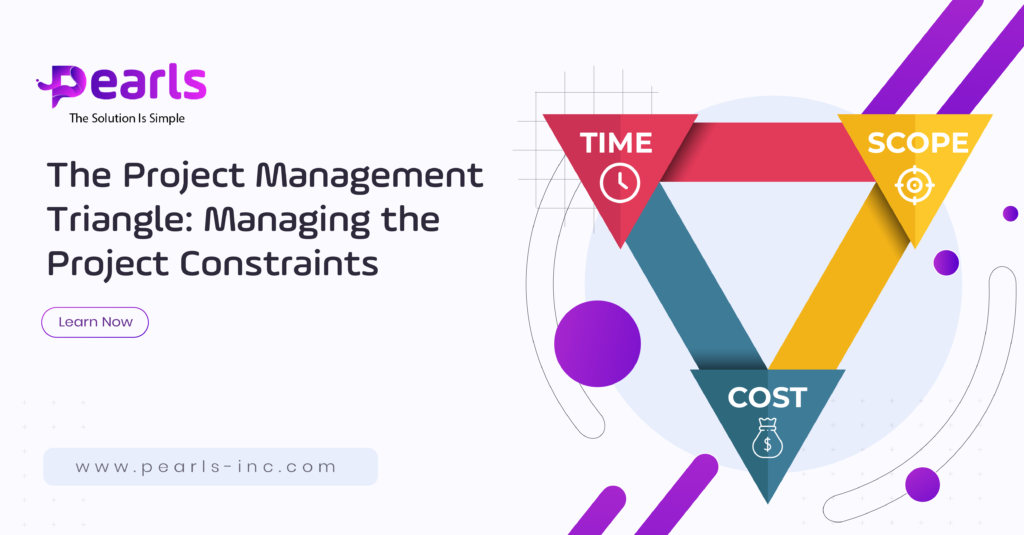
The Project Management Triangle is one of the most if not the most, important concepts in project management. It has multiple names, including The Triple Constraint, Iron Triangle, and Project Triangle. It unveils the significance of the Project Management Triangle in managing any project. The Project Triangle has three constraints: cost, scope, and time. These constraints are part of every project, but understanding these is more complex than it might seem.
What are Project Constraints? Project Management Triangle
The project constraints named above can be the limiting factor for any project, and if managed properly, they can have no negative impact on the success of a project. However, it is also important to note that properly working these constraints cannot guarantee the project’s success because the project’s success depends on various other factors.
Still, time, cost, and scope are three of the most important factors, which is why the Project Management Triangle has become a core concept in project management. These three constraints are inversely proportional to each other, which means that if one condition is dealt with, the other two, or at least one, will be negatively impacted. To understand each of these project planning regulations, we will look at each in detail below.
Time
Time is the most crucial element of any project, and it is something that cannot be escaped. Every task, report, feature, app, or anything in the project made takes time. The time can be saved or added, depending on the quality and quantity of the resources handling the project. The duration depends on multiple factors like how skilled the resources are, which is working on them, and how many resources there are.
Deadlines are significantly important in project management. The crucial part about time is to hit the deadline and deliver the project as planned eventually. To meet the deadlines, the project managers may have to reduce the project scope or increase the number of resources. This way, time can be saved.
Scope
Scope revolves around the product which is being dealt with in the project. From what is being made? The features, functionality, and everything else being integrated into the product are part of the scope. The more things or features you add to your product, the better it might get and the more competitive it can be in the market. However, adding these features to the product will require more time, money, or both.
The bigger your product idea is, the longer it will take to complete it as per the planning or expectations. It will certainly increase the cost as well. If the pressure to deliver comes in, which is common in project management, then you might have to limit the originally planned scope to deliver on time or reduce the cost. On the other hand, you might have to add more budget for the number of resources to get your product ready with the full scope in the planned time.
Cost
The project budget is usually one of the most significant constraints in project management. Cost is more associated with a scope rather than time, but still, all three of the project management constraints of the Project Management Triangle have impacts on each other. The budget assigned to a project is usually set before the beginning of the project, and it stays the same in most cases. However, whenever the scope of the project is increased, the deadline of the project is also extended, which requires the cost to be changed as well.
When the deadlines are not changed, and the scope is increased, then the project’s cost increases significantly more than planned prior to the project. The increase in cost can be due to the added quantity of resources or due to the extension of the deadline, which increases labor costs. In any case, the price will increase whenever the scope is expanded in any project.
Managing these Project Management Constraints
In order to effectively manage these project constraints, the project managers should understand that the project management triangle will always be there. These project constraints cannot be escaped or removed from any project. Strong project managers understand the following realities very well.
- All the projects are different, and each has a different blend of constraints
- Whenever the scope cannot be changed, the cost or the timeline, or both will have to be changed
- Whenever the timeline cannot be changed, the scope or the cost, or both will have to be changed
- Whenever the cost cannot be changed, the scope of the timeline or both will have to be changed
The most important part of effectively managing these project constraints has transparency. If the project manager has to make a decision, it should be based on the proper understanding of the particular project’s constraints. The decisions made based on project constraints will be right for the product, and it can lead to the successful and timely delivery of the project.
So, the project manager must keep all the team members, stakeholders, and other involved members informed about all the happenings. The priorities need to be properly planned and set in advance. Everyone needs to be fully clear about the objectives of the project. If you understand the project constraints, you will know where the project can be bent and where it cannot be. It will lead you to make the right decisions for the project and help you deliver a successful end product by best managing the project management constraints.




